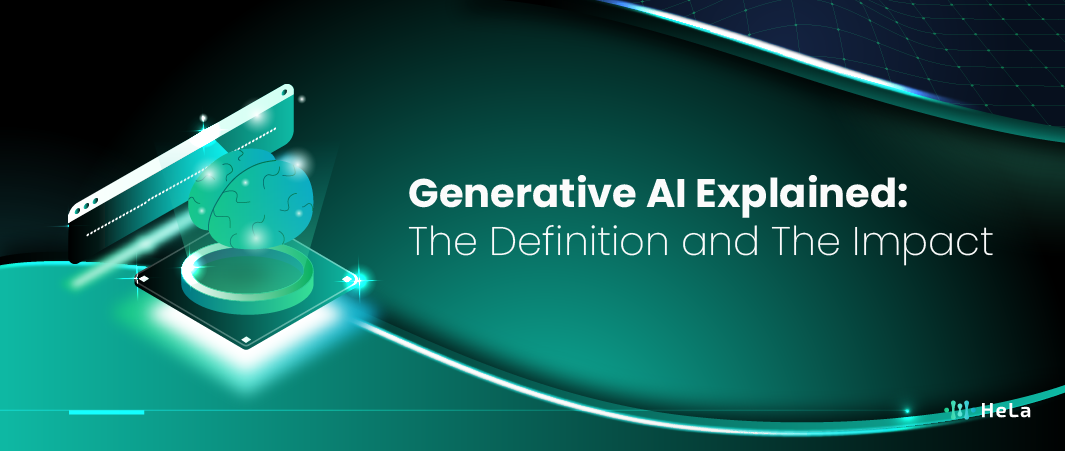In this article, we will explore how Generative AI works, the significant impact it has already made, and its future full of potential. If you’re interested in how AI can change the way we work, learn, and create, and want to understand its challenges and opportunities, this article will provide a comprehensive guide to enrich your insights. Read on to discover how this technology is evolving and how we can approach it wisely.
This technology is revolutionizing various industries, from creative arts to business, by introducing innovations that enable smarter automation and collaboration. From creating artworks to crafting more personalized marketing strategies, Generative AI opens up endless new opportunities. However, it also brings challenges in terms of ethics and regulation that need to be understood more deeply.
What is Generative AI?

This is a subfield of artificial intelligence (AI) in which the AI programs are trained to produce new content based on the patterns or data given to them. In contrast with classical AI which has goal to recognize something, classify or predict something or even do something, Generative AI aims at creating something new, for example text, image, music, code etc. This technology works under the principle of analyzing patterns from data available and then adapting those patterns to create similar but original content.
An example of Generative AI is the application of models such as GPT (Generative Pre-trained Transformer) for text generation. This model is matured with millions of text data, which enables it to guess and generate sentences that are rational and proper for the given context. Apart from text, Generative AI is also used in other domains as well, including, for instance, the ability to create new images using AI tools like DALL-E, which can generate innovative and distinct images based on a given textual description.
Machine learning is also developing rapidly in music and video creation. To mention some of them, the AI can be used for creating new songs basing on the analysis of the patterns in thousands of songs or for generating new animations that have never been created before. For the creative industry, this presents a clear advantage in fostering the fast and effective generation of content as well as research into artistic styles. But with it comes new problems like ethics, copyright, and the susceptible to misuse of Generative AI.
Speaking of Generative AI in everyday life, it becomes a part of numerous applications and tools used in digital environments, ranging from voice assistants to creative software. Given its capacity to gain insights from big data and generate new material, this technology is quite promising in many disciplines. Nevertheless, with benefits come risks and that must be a constant discussion – more specifically how to approach the usage of AI safely and ethically.
How Does Generative AI Works?

Generative AI operates by employing machine learning algorithms that can identify patterns in the already existing content and create new material based on those patterns. This generally involves artificial neural networks particularly the transformer or Generative Adversarial Networks (GANs) where the model is trained to identify a structure or recurring patterns from corpora like text, image, sound or others.
For text, an example is the GPT model which is trained by reading millions of sentences from different sources. They use a model that finds out the subsequent word of a statement depending on the words before it. Once the model understands these patterns, it can be utilized to synthesize more coherent text. For instance, if you provide the starting line as “Once upon a time. . .”, the machine will generate a full story based on the nouns and verbs patterns accrued during its spars.
In images and videos, the Generative AI models including GANs work somewhat diversely. GANs consist of two parts: There are two main components of GANs, namely a generator and a discriminator. The generator attempts to produce images which look like real images while the discriminator on the other hand acts like a ‘critic’ seeking to distinguish between real images and fake images generated by the generator. These two parts constantly train and fight with each other, until the generator itself is extremely efficient in creating fake images much like the real ones and even the deepest analytical tools cannot distinguish between the two.
Also Read: 10 Best Enterprise AI Development Companies in 2024
This generative process is computationally intensive and needs data in gigabyte range. In order to generate good quality output, the input to an AI model should be highly specific and the models should be trained from a large number of samples. Therefore, the advanced AI benefits from the availability of more data to produce even more new content. However, this also creates problems regarding computational complexity and training period. Furthermore, Generative AI can produce high-quality content, however, it is not fully unique, as its content originates from patterns that were identified during the data training process.
5 Most Popular Generative AI in the World

The world of AI has really developed lately, proven by this Generative AI. Here are five of the most popular and widely used Generative AIs today, with exciting applications across various industries:
1. GPT (Generative Pre-trained Transformer) by OpenAI
GPT is one of the most popular Generative AI models in the world at the moment, especially the newest versions such as GPT-4. ChatGPT is commonly employed to produce text that looks like it was written by a human, ranging from articles, fictional stories, and conversations.
Despite being trained on billions of words from the internet, GPT can cope with respect to context and generate very natural responses. This is commonly utilized in applications such as chatbots, automatic writing, and writing assistance, particularly when it comes to creative writing.
2. DALL-E
DALL-E is another one of OpenAI’s Generative AI designed to generate images from textual inputs. For example, you can set a description like ‘an elephant playing piano on a cloud,’ which will result in DALL-E creating an image based on that description.
They have expanded the boundaries of digital art, Decentralized designs, and any form of automatically generated content. This capability is very versatile and beneficial for artists and creators who wish to materialize their artistic visions.
3. DeepArt
DeepArt is an application that applies AI for the purpose of turning ordinary pictures into art pieces of classic or the modern genre With the help of neural networks similar to the GANs, this turn makes artistic effects on pictures.
Whether it be a snapshot of your pet or baby, a selfies or your hometown’s landscape, users can select an art style from the wide array of options as the famous artists such as Van Gogh or Picasso, and through the use of AI, DeepArt will transform that particular image into an art masterpiece.
4. Runway ML
The ability to use AI for generating videos, animations, and visual effects is one of the key aspects that makes Runway ML quite popular among artists and video creators. Runway ML also offers numerous AI models which are available for generating generative content.
With this tool, users can select a movie-like theme and make videos with cinematic effects or switch backgrounds of the video automatically or even generate animations from the supplied text. Runway ML has been applied in a variety of art projects including ads and movies.
5. Jukedeck
Jukedeck is a generative AI tool that can be utilized to generate music. This online music service based on machine learning lets users create new music by specifying a few parameters, including genre, mood, or length of the song.
The music created can be incorporated in any project ranging from YouTube videos, podcasts, and even in advertisements. For content creators who require special music without involving musicians, this AI is ideal because of its efficiency and outcome.
The Impact of Generative AI
AI has definitions in meaning creating, where it is used in creative work, business, and daily life. In the creative industry, this AI has changed how artists, designers, and content creators proceed with their work entirely. As Generative AI can automatically create text, images, music, and videos, it decreases the time needed to develop them and expands the possibilities of creative work. Artists and designers are no longer restricted by conventional technicalities as AI can help in crafting more intricate and creative pieces. It also allows the humans and the machine to work together, the artists may choose to assist the machine in creating works that align with their imagination.
In the business context, Generative AI introduces new value across sectors, such as content generation, product design, and even application development. For instance, marketing departments may employ AI to personalize the marketing messages or even to create new products that will potentially interest customers. Furthermore, with the help of AI, developers get an ability to automatically generate code, which can save significant amount of time spent on creation of apps and other types of software. It also cuts down on costs and time, as well as helps organizations respond to shifts in the market and consumers faster.
Another area where generative AI is quite prominent is the realm of interacting with everyday technology. Recent virtual assistants, chatbots, or smart home devices can now converse with the user more fluently thanks to the generative function. Furthermore, in the context of education, Generative AI can be employed to generate teaching resources that should meet the learner’s needs, thereby providing increased efficiency and productivity of their learning process. This technology also aids in creating simulations and practice exercises that can improve practical learning in diverse fields including health or engineering.
Also Read: Top 12 AI Consulting Companies to Consider in 2024
Nevertheless, Generative AI also has its drawbacks that must be considered while enjoying all the strengths that it has. Another concern revolves around the potential vulnerabilities of this technology for malicious purposes, including the generation of deepfakes or the posting of fake news. AI using sophisticated techniques to create raw and true to life contents can be exploited in immoral ways such as spoofing over videos or voices. More so, ownership and copyright claims to works that are created by AI are still an area of discussion. This is why clear and ethical rules must apply to Generative AI so that it will not negatively impact others.
The Future of Generative AI
Generative AI has a bright future hovering over its prospects to revolutionize different facets of life in the future. Since the development of this technology is progressive, it is only a matter of time before the AI becomes smarter and can produce even better and more creative content. Artists and designers in the creative field will find AI as their working tool, making them produce even more amazing wonders which used to be impossible to achieve without the help of an AI. The use of generative AI could also precipitate new kinds of art and communication that would have been impossible in the past.
In business, there is a great potential for the future of Generative AI to deliver more profound and complex levels of automation. This will allow companies to design products, services, and business strategies through AI using custom-built analysis of details. Generally in marketing, AI could design full bespoke marketing campaigns for each potential customer which would substantially enhance their response rates. In addition, AI will unlock the possibility for developing new, more effective, and versatile value propositions that can respond to change and adapt dynamically to market conditions.
In training and education it will help deliver material that is relevant to each learner as the role of Generative AI becomes more significant. It could make the education more engaging and closer to real-life, with more relevant simulation and related exercises. For instance, medical education can employ Generative AI to develop more intricate models of surgeries, and language acquisition can be amplified by offering dialogues that act as real-life discussions. This will make learning faster and enhance training in different fields by using this helicopter approach to learning.
The future of Generative AI also holds some issues that are yet to be solved However, the future of Generative AI also presents its challenges that need to be considered. With the increase in complexity and application of AI, issues of ethical and regulatory nature will begin to arise. The question that one tends to rise is, how can we ensure that this technology is utilized in the right manner and not for the wrong reasons that involve on uploading of fake news or inflicting harm on users? Other questions concerning copyright and ownership of the materials created by AI shall also arise. Of course, in the future, it will be necessary to establish clear guidelines and rules for the use of Generative AI and other AI technologies so that innovations can be used fairly and in the interest of all participants.
Conclusion
Generative AI Explained: The Definition and The Impact has shown how this technology is significantly transforming various industries. From creating new content to automating business processes, Generative AI opens up endless opportunities for innovation. By leveraging data to generate original work, this AI assists artists, designers, software developers, and business professionals in delivering more efficient and creative solutions. However, alongside its benefits, this technology also brings ethical and regulatory challenges that need to be addressed.
Moving forward, Generative AI will continue to evolve and become more sophisticated, enabling wider integration across various fields. It is essential for us to understand this technology, harness its potential wisely, and address the emerging challenges responsibly. With proper regulation and ethical use, Generative AI can become a positive force shaping the future of creativity, business, and education.
Disclaimer: The information provided by HeLa Labs in this article is intended for general informational purposes and does not reflect the company’s opinion. It is not intended as investment advice or a recommendation. Readers are strongly advised to conduct their own thorough research and consult with a qualified financial advisor before making any financial decisions.

